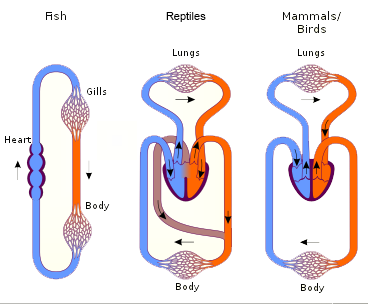So Many Different Hearts; Beats Me How Evolution Works
All of us are familiar with the picture below. But how did nature get here? What triggered our ancestors to learn to walk on two feet? And how did species develop from swimming the oceans to crawling on land? Evolutionary biology is the science that studies the history of life forms on earth.
 A field related to evolutionary biology is 'zoophysiology’, which seeks to shed light on how animals function. What are the physiological adaptations that enable animals to thrive across virtually any environment on earth, and how can some of these adaptations reveal general principles that govern life functions? In this blog I would like to highlight some of the work of Dr. William Joyce, one of our long standing customers and researcher at the Department of Zoophysiology at Aarhus University in Denmark. Together with close collaborators, he studies snapping turtles, alligators, pythons and other exotic non-mammalian species. Not your most common lab animals for sure!
A field related to evolutionary biology is 'zoophysiology’, which seeks to shed light on how animals function. What are the physiological adaptations that enable animals to thrive across virtually any environment on earth, and how can some of these adaptations reveal general principles that govern life functions? In this blog I would like to highlight some of the work of Dr. William Joyce, one of our long standing customers and researcher at the Department of Zoophysiology at Aarhus University in Denmark. Together with close collaborators, he studies snapping turtles, alligators, pythons and other exotic non-mammalian species. Not your most common lab animals for sure!
At first glance, we do not seem to have a lot in common with turtles, lizards or snakes, so why study them? Dr. Joyce explains "Most reptiles have a three-chambered heart with two atria and one ventricle. The scientific community looks at them as an intermediate state between fish with their two main chambers (one atrium and one ventricle) and mammals with their four-chambered heart (two atria and two ventricles). Understanding how evolution has changed the capacity of the heart in different species, including how we developed to the four-chamber heart, will help us to better understand the broad functionalities of the heart."
What is the function of that three-chambered heart that most reptiles have? Dr. Joyce clarifies "It allows blood to mix in the heart, and for example during diving in aquatic species, allows blood flow to bypass the pulmonary circulation when they are submerged. It is still debated what the main benefit to this is, but many ideas have been proposed. For example, in deep diving sea turtles and sea snakes, bypassing the lungs could prevent gas entering the blood stream to avoid decompression sickness. There is even the possibility that by studying the reptile heart, which mixes oxygen-rich and oxygen-poor blood, we can understand more about human pathologies involving ventricular septum defects, where blood can also mix in the heart. In reptiles this state may be beneficial as suggested above, or at least not harmful, but in humans with higher metabolic rates it is pathological."
Reptiles are also interesting in the sense that reptile eggs can be exposed to hypoxia during embryonic incubation. In comparison with mammalian development, if the embryo is exposed to hypoxia with a reduced blood supply, it has life-long consequences that can often be detrimental. But in reptiles where the eggs are often naturally exposed to hypoxia, it can remodel the cardiovascular system, potentially to the benefit, for example bigger relative heart size and altered autonomic regulation.
Finally, reptiles can survive in extreme environmental conditions. "We study freshwater turtles," Dr. Joyce tells, "because they can survive weeks or even months without breathing when they hibernate in ice-covered lakes during winter. Their heart slows down to just a few beats per minute, but it keeps pumping." By studying unusual animals like reptiles, Dr. Joyce and his colleagues believe that we open our eyes to diverse solutions to common problems such as how to regulate cardiac output. As with many discoveries, it may take a while to translate or implement, but it is all about expanding our knowledge of the limits of cardiac function.
Like the unique research species above, our vascular flowprobe were customized to meet the needs of Dr. Joyce. These studies required flowprobes to be calibrated for blood flow at low temperatures instead of the usual 37°C used in mammalian/endothermic species. In addition, the placement of multiple flowprobes on different vessels of an alligator heart, required synchronization of the probes to optimize flow measurements. This is great example of the level of partnership we at Transonic are proud to offer: combining expertise from you, the scientist, and from your trusted application specialists.




